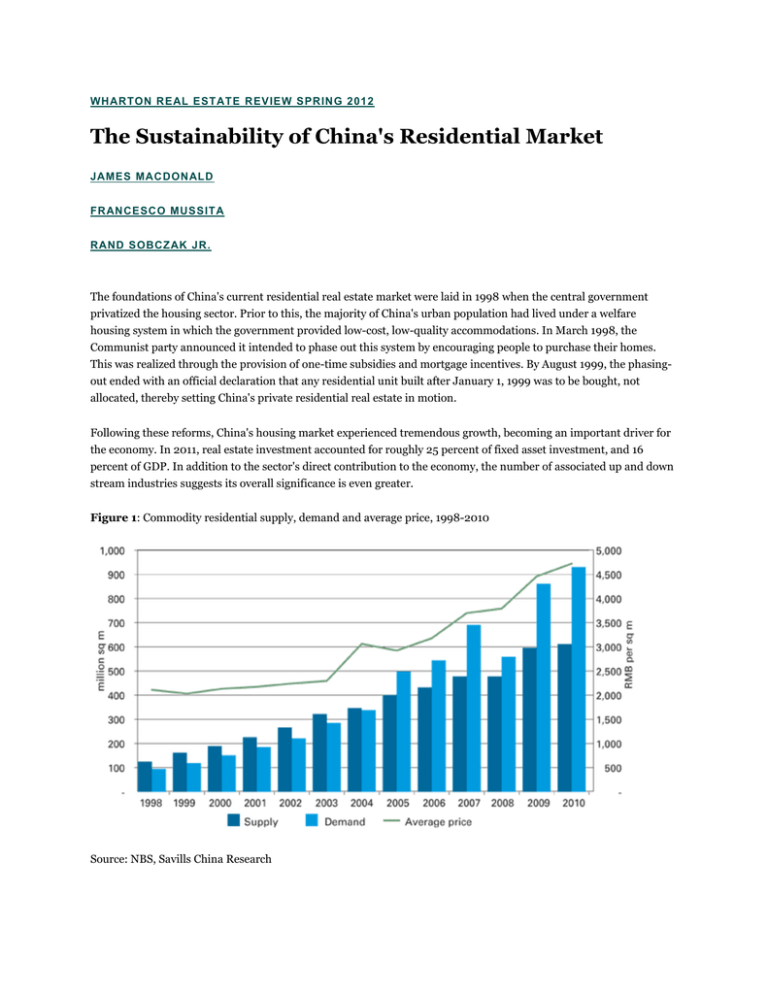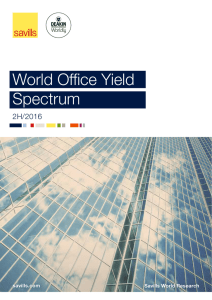The Sustainability of China's Residential Market
advertisement

WHARTON REAL ESTATE REVIEW SPRING 2012 The Sustainability of China's Residential Market JAMES MACDONALD FRANCESCO MUSSITA RAND SOBCZAK JR. The foundations of China's current residential real estate market were laid in 1998 when the central government privatized the housing sector. Prior to this, the majority of China's urban population had lived under a welfare housing system in which the government provided low-cost, low-quality accommodations. In March 1998, the Communist party announced it intended to phase out this system by encouraging people to purchase their homes. This was realized through the provision of one-time subsidies and mortgage incentives. By August 1999, the phasingout ended with an official declaration that any residential unit built after January 1, 1999 was to be bought, not allocated, thereby setting China's private residential real estate in motion. Following these reforms, China's housing market experienced tremendous growth, becoming an important driver for the economy. In 2011, real estate investment accounted for roughly 25 percent of fixed asset investment, and 16 percent of GDP. In addition to the sector's direct contribution to the economy, the number of associated up and down stream industries suggests its overall significance is even greater. Figure 1: Commodity residential supply, demand and average price, 1998-2010 Source: NBS, Savills China Research This growth has been encouraged by the establishment of mortgage financing in 1998 and a government stimulus package implemented as a reaction to the 2008 global financial crisis. Consequently, the volume of mortgage loans issued has grown significantly over the past decade, most notably in 2009. These two factors, however, represent a developing consumer credit market and a temporary government response rather than a sustained driver of housing demand. Growth in the sector has been more notably supported by favourable demographic trends, rising incomes upgrade demand and a lack of alternative investment opportunities. A significant driver of China's economic miracle has been the migration of people from rural to urban areas (Figure 2). By 2011, China's urbanization ratio, the proportion of the population living in urban centers, had exceeded 50 percent, up from 35 percent in 1999. Figure 2: Urbanization rate, 1950-2050 Source: United Nations, Savills China Research In addition to the sustained urban migration, the country has also benefited from a demographic dividend. Between 1995 and 2010, the working age population, the number of people aged 15 to 65 years as a percentage of the total population, has risen from 66 percent to 72 percent (Figure 3). Incomes in China have also increased significantly following the liberalization of the housing market. Between 1999 and 2010, nominal urban disposable incomes per capita have risen by a compound annual growth rate (CAGR) of 10.4 percent, from Renminbi (RMB) 5,854 (US$929) per year to RMB21,734 per year (US$3,500). Furthermore, demand for new housing is also fueled by upgraded demand. As pre-reform housing provisions were commonly small and of poor quality, the desire for larger, more modern units has helped support the development of the residential real estate market. This has been noted through the steady increase in per capita living space over the past decade (Figure 4). Lastly, an underdeveloped capital market is a strong driver of the market, which has been reflected through a closed capital account, low real bank deposit rates, volatile stock market returns and a small bond market. This has incentivized households to allocate a large proportion of their savings and investment activity to residential real estate (Figure 5). Figure 3: Demographic dividend, 1950-2050 Source: CEIC, Savills China Research Figure 4: Urban and rural per capita living space, 1985-2010 Source: CEIC, Savills China Research Figure 5: Western vs. Chinese household balance sheets Source: World Bank, Savills China Research Smoke and Mirrors Following privatization of the housing sector, prices throughout the country have risen dramatically, raising questions as to whether current levels are sustainable. Bubble indicators such as price growth, average yield and vacant units have pointed towards an increasingly overheated market. While such gauges should be monitored closely, they should also be interpreted in tandem with the unique characteristics of China's housing sector. Arguably the most commonly referenced indicator of a property bubble is a large sustained increase in prices over a lengthy period of time. In the most recent U.S. bubble, prices rose by a CAGR of 13 percent between 2000 and 2005, culminating in a large one-off correction with long-term domestic and global economic implications. According to figures published by the National Bureau of Statistics (NBS), prices in China have risen by a CAGR of around 16 percent between 2005 and 2011 (Figure 6). With the consequences of the sub-prime crisis in the United States still in many people's minds, such growth has caused many to fear that the housing market in China has also reached dangerous levels. Figure 6: Residential price index by tier, Q1/2005-Q4/2011 Source: NBS, Savills China Research Some critics argue that the data provided by the NBS does not accurately capture price movement. Average transaction prices are used to track values and fail to take into account an increase in the quality of new units. Over the past ten years, the majority of stock supplied to the market by Chinese developers has targeted buyers in the upper 40 percent income bracket and has come with significant improvements in quality and facilities. This perhaps explains a proportion of the price increase witnessed in the market. Following the wake of the U.S. housing collapse, the implications of overleveraging on cheap credit has re-emerged as a cause and a probable indicator of housing bubbles. In China, this has not been a large concern, as prospective buyers are subject to down payment requirements of 30 percent to 60 percent. Furthermore, due to a cultural aversion to debt, households have been keen to service their loans ahead of schedule and have not drawn down on their mortgages or refinanced their debts on the increased value of their homes. Nevertheless, the pace of price growth has been accompanied by a wide consensus that home ownership is no longer affordable for the general population. For example, most working couples in Shanghai are eager to purchase a home. Assuming both husband and wife work for foreign-invested enterprises in the tertiary sector, NBS figures suggest that their household annual income would be about RMB169,000 (US$26,800). But a two-bedroom apartment within one hour's commute of the city center sells for about RMB1.9 million (US$301,600). On average, it would take three and a third years to raise the down payment, and eleven years of total earnings to purchase the apartment free and clear. Although critics claim Shanghai is an exception, as it attracts a considerable amount of investment from outside the city, affordability in second- and third-tier cities is similarly restricted. A conventional affordability ratio, calculated by dividing the average price of a 90-square-meter apartment by the average household disposable income, is 21.4 for Shanghai, 22.5 for Chengdu, and 20.5 for Tianjin. In developed markets such as the U.K., the comparable affordability ratio has never exceeded six over the past twenty-five years. One can argue that the data used in calculating the Chinese affordability ratio fail to take into account an underdeveloped low-end housing market, the disparity of wealth, rapidly rising incomes, and unreported or grey income. According to UBS economist Tao Wang, the total volume of new housing supplied in China between 1997 and 2010 was approximately 54 million units, while the total number of urban households in 2010 stood at around 215 million. This relatively small housing production has targeted households with above-average incomes, which are more profitable to builders and developers. This suggests that over the short period of time the private housing sector has been in existence, a private market for low-end housing has not yet been established. In addition, China suffers from substantial income inequality. Those in the upper 40thincome percentile are estimated to take home 40 percent to 220 percent more in unreported income per annum than NBS figures suggest (Figure 7). Once affordability indicators are adjusted to include only those in this income bracket, they appear closer to the international norm. This perhaps explains why property sales had remained buoyant prior to government cooling measures, despite the low level of buyer leverage and a high price to income ratio. Figure 7: Average income and grey income, 2008 Source: Credit Suisse, Savills China Research Another benchmark used to assess inflated housing prices is the rental yield, the average rental income divided by the average price, which measures buyers' approximate returns on their investment. If yields fall close to or below borrowing costs, it suggests that homes are overpriced and/or investors are seeking income on their property primarily through capital value appreciation. In first-tier cities such as Beijing, Shanghai, Shenzhen and Guangzhou, return yields are estimated at 2 percent to 3 percent, and declining (Figure 8). This data, based on nine projects in each city, three of which are in the low, mid and high end of the market, suggests a degree of speculative investment pushing prices higher and a preference towards purchasing rather than leasing property for end-use. Figure 8: Commodity residential market yields and mortgage rates, Q1/2005-Q4-2011 Source: Savills China Research Another indicator used to measure the presence of a housing bubble is the number of vacant units. Like yields, high vacancy rates point towards greater investment speculation, as purchases do not reflect end-user demand. Such data, however, is hard to obtain, and although a large volume of empty homes is evident in certain cities the exact number remains unknown. For example, in March 2010, an initial announcement from the State Electricity Company showed that electricity meters in more than 65 million houses remained at zero for more than six consecutive months. This figure, however, was later denied by the authorities. Nevertheless, it suggests that China's estimated nation-wide vacancy rate could be in the range of 15 percent. Concerns about vacancy have also been taken to citywide levels. For example, a large-scale urban development zone on the outskirts of Ordos in Inner Mongolia was built to house more than one million people. By 2010, the government announced, only 28,000 people had taken up residence, although even that number was met with scepticism by many. Similar, if less dramatic, examples have been noted in other areas around the country, and highlight that while speculation is present in specific regions, it may not necessarily be a nationwide phenomenon. Figure 9: Ordos, Inner Mongolia Source: Chinacity The Government Response Despite the lack of clear evidence of a property bubble, home prices have become a significant social issue, prompting the government to react to public discontent. In a survey of urban depositors conducted in the fourth quarter of 2011 by the People's Bank of China, 69 percent of those polled believed that housing prices were unacceptably high. Taking all factors into consideration, the government reacted by implementing a series of policies designed to cool the market. The specific measures are broadly categorized as below. Down payment requirements: Led in large part by the State Council, China's chief administrative authority, down payment requirements for first and second home mortgages were raised in order to curb speculation, while third home purchases were forbidden. These measures were implemented throughout the country. Home purchase restrictions: Arguably seen as the most significant reform of all, home purchase restrictions (HPRs) forbid the purchase of multiple homes per household (typically more than three) and the purchase of homes without established residency in the city. These restrictions vary from city to city but their primary purpose is to reduce the number of investment home purchases. Home price targets: These are parameters with which the authorities would like residential prices to grow. Targets are based on first-hand average transaction prices and include social housing. In 2011, seventy cities had issued such targets. Some—notably Shanghai, Shenzhen and Guangzhou—have chosen to keep residential price growth below GDP growth, or per capita annual income growth, while others (Beijing) are determined to see prices decrease. Many of these targets have been extended to 2012. Limiting participants in development: In March 2010, the State Council ordered state-owned enterprises (SOEs) whose core business was not real estate-related to exit the market once their developments were complete. This measure was in reaction to firms without sufficient real estate experience engaging in irrational construction. The Ordos urban development, for example, was almost exclusively financed by firms in the natural resources industry. Property tax: Shanghai and Chongqing, two of China's largest urban centers, have inaugurated an annual property tax on homeowners. These taxes are seen as a trial, with the probability that similar reform will be implemented in other cities, or possibly countrywide. Although the taxes in the two cities differ, their objective is to raise the holding cost of residential property, thereby reducing speculative activity, and alleviating local governments' dependency on land sales as a source of revenue (Figure 10). Figure 10: Local government revenue breakdown, 2000-2010 Source: NBS, Savills China Research Social housing: To satisfy the need for low income housing, the State Council has established quotas for the construction of social housing. In 2012, for example, seven million social housing units have been earmarked for construction. This initiative is being carried by local governments in conjunction with sometimes reluctant developers who see little profit in the endeavor. Strong government relationships, however, are a significant advantage to doing business in China. Moreover, developers may be enticed by the steady stream of revenue the program would provide . As a result, homebuilders are likely to be supportive of these efforts going forwards. Whether such developments' quality will be built to reasonable standards is not clear. Furthermore, while the government claims that objectives had been met in 2011, skeptics argue that developers simply had to build basic foundations to fulfill targets. Nevertheless, the initiative is expected to provide much needed housing stock to the lower end of the market. Table I: Recent government regulations on the residential market Source: Savills China Research Chinese housing reforms (Table I) can be broadly split into two categories: short-term and long-term. Short-term initiatives include down payment requirements, home purchase restrictions and home price targets. These are aimed at providing temporary relief to a market that has been perceived by many to be overheating. While it may be some time before they are repealed, their goals are for temporary relief. On the other hand, market consolidation, property taxes and social welfare housing are seen as long-term initiatives to address structural problems in the residential real estate market. The consolidation of industry players is expected to simplify regulation and monitor development more effectively. Property taxes will increase holding costs, thereby encouraging owners with investment properties to lease their units. Finally, social welfare housing is expected to help satisfy an undersupplied low-end of the market and support the construction industry (and economy) as the commodity market continues to cool. Risks The future direction of the Chinese residential sector is a much debated topic. In the short term, the argument lies in whether price declines will exceed the correction the government is targeting. In the long term, the argument shifts to whether the fundamental drivers of demand can be sustained and whether they justify the volume of new supply coming onto the market. Engineering a soft landing will be a difficult task for the government, as it requires walking a fine line between placing downward pressure on price growth without drastically stifling an industry that accounts for more than 15 percent of GDP. The authorities want home prices to fall but not by an amount that would severely hurt developers, other upand down-stream industries, banks or local governments. Therefore, the looming risk is if the achievement of a target price correction is followed by large-scale mortgage defaults and forced sales, extensive developer discounts, and/or the establishment of an irreversible downward price expectation. Due to cultural factors, government regulations, and an immature consumer credit market, households in China have shown an aversion to debt and have not overleveraged. Consequently, outstanding mortgage debt in China represented only 16 percent of total GDP in 2010 (in the United States, this ratio in 2006 reached almost 80 percent) and homeowners typically have high equity holdings on their properties (Figure 11). This reduces the risk that they will walk away from their debt obligations if the value of their home falls. Figure 11: Outstanding mortgage debt as a proportion of GDP, 2005-2010 Source: CEIC, Savills China Research Developer liquidity pressure is also unlikely to trigger a collapse in prices. In the second half of 2011 many developers began to offer discounts in the range of 10 percent to 15 percent with reports of 30 percent to 50 percent drops in prices being exaggerated. These efforts, however, are largely attributed to their eagerness to achieve sales targets and give a boost to end-of-year performance reviews rather than an act of financial desperation. In addition, large established developers exhibit a sufficient level of insulation from a potential drop in demand. They are expected to hold sufficient cash reserves and access to alternative financing options through partnership agreements, equity sell offs, corporate bonds and government support. Small developers, on the other hand, are at a greater risk. They are less likely to be able to tap into such channels amid the government's tight monetary stance. This will give incentive to smaller developers to cut prices further in a bid to accelerate sales and could erode market confidence. While short-term issues are likely to remain the focal point of discussion in the near future, long-term trends supporting the market are also very important. For example, China's working age population is expected to peak by 2015, receding thereafter. Aside from the burden this will put on those who will need to take care of their parents financially—as China has little in the way of a social safety net in place for the elderly—this means there will be fewer and fewer first-time home buyers, limiting new demand. Arguably the strongest real estate driver in years past, and the one most susceptible to change, is the lack of alternative investment options. A goal outlined in the central government's 12th Five-Year Plan issued in March 2011 is to achieve basic convertibility of its capital account by 2015. Coupled with further expectations for financial liberalization, such as the development of the bond market, greater legal protection and the internationalization of the RMB, the role real estate plays in individual investment channels will most likely be reduced. Other demand drivers are likely to continue. China's urbanization rate currently stands at around 50 percent; taking industrialized nations' statistics into account, more people are expected to move to urban centers in the years to come (Figure 2). Finally, incomes are expected to rise, albeit at a slower rate. On the one hand, China's economy is expected to slow in the coming years as investment and export growth slows. On the other, initiatives to promote domestic consumption, including increased social benefits, will support the development of the services industry, economic growth and, consequently, employment and incomes. Upgraded demand is therefore also likely to further support the construction of new starts with post-reform commodity housing representing only 38 percent of the total housing allocation in 2010. Conclusion Although rapid price growth and affordability in housing have occurred, their ability to prove the existence of a housing bubble is limited. A low affordability ratio may represent high income inequality and an undersupplied low to mid-end market. Statistics on price growth fail to take into consideration adjustments in quality and similarly high levels of income growth. Nevertheless, low yields and anecdotal evidence of high vacancy lend support to the idea that current levels of development may not be sustainable in the long-term. Short-term policies addressing sustainability have cooled the market but have also triggered fears of a correction in prices exceeding intended targets. We believe these concerns to be unfounded. Fundamental drivers of demand are expected to act as a sufficient floor to prices. Furthermore, limited leverage would mitigate the risk of forced sales, while strong balance sheets for large developers would reduce the possibility of significant widespread discounts. In the mid-term, fundamental drivers of the market are expected to recede. Real estate is unlikely to maintain its status as the most attractive investment, while the size of the working age population will eventually contract. Given the sheer size of the real estate industry and the number of sectors that depend on its growth, this will undoubtedly put strain on the economy. The extent to which this dampens China's overall economic outlook now depends on the execution of the authorities' broader response. This is not limited to social housing targets and a property tax; it includes measures to develop the services sector and domestic consumer demand as new sources of economic growth. Copyright 2012 James MacDonald, Rand Sobczak, and Francesco Mussita .









